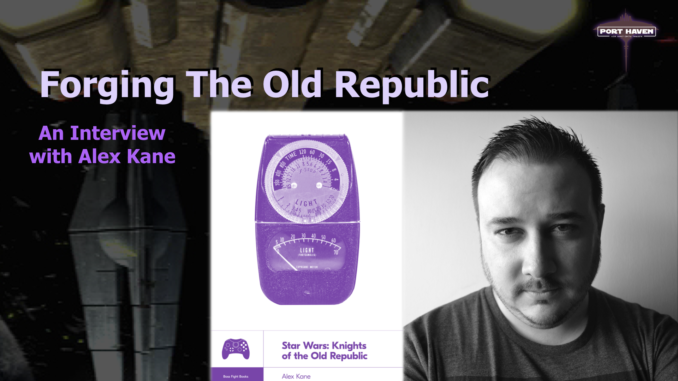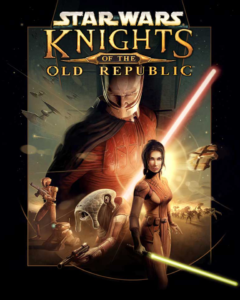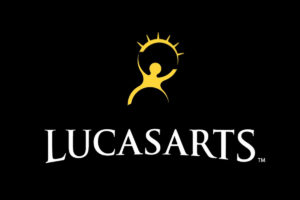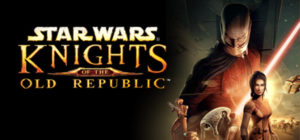
If you talk to anyone who’s played Star Wars video games then it’s most likely that they’re going to tell you that Knights of the Old Republic is their favorite. In many ways it’s The Empire Strikes Back of the Legends Canon universe. Alex Kane has written a wonderful behind-the-scenes book about the development of Knights of the Old Republic (KotOR). It’s filled with interviews and stories about the game from the earliest development right until the end. I got the chance to chat with Alex and ask him some questions about himself and about the book.
YB: How did you get into journalism? What sparked the writing bug?
AK: I’ve wanted to be a writer since I was about ten or eleven, writing and illustrating my own goofy sci-fi stories at school. Picture sort of a Dragonball Z–meets–Star Wars crossover universe. During college, I read Stephen King’s On Writing and published a number of short stories and essays professionally, and that gave me a lot of confidence I might not have otherwise had.
In 2013, I attended the Clarion West Writers Workshop in Seattle, where I studied under Joe Hill, one of my writing heroes, and a bunch of other brilliant teachers. And that experience, while amazing in so many ways, kind of killed my ability to read and write fiction for a few years. So I turned to doing freelance editing and some other stuff.
One day, I saw a tweet from an editor at Kill Screen who was looking for people to write news, I fired off an email, and I’ve been writing about games regularly ever since. I got very lucky.
YB: What was the first video game you played? What was your first Star Wars game?
AK: My first video game was Super Mario Bros. 3, and then of course I went back and played the first and second games in the series. My first Star Wars game, however, was Shadows of the Empire. I essentially grew up with the Nintendo 64, so things like Rogue Squadron and Episode I: Racer have always been near and dear to my heart—even if most of my favorites were actually the Star Wars games coming out during the Xbox era a few years later.
YB: If you could only play one video game for the rest of your life, what one would it be?
AK: Right now, my answer would probably be Skyrim, because it’s endlessly replayable, and I really love the Elder Scrolls series. But Super Mario Maker’s about to get a second life on the Switch, with Super Mario Maker 2, so my answer could be changing very soon. I adored the first Mario Maker on Wii U, and I suspect the Switch version might become a bit of a phenomenon.
 YB: How did you get involved with writing for Boss Fight Books? Did they offer you the chance to write about Knights of the Old Republic, or did you pitch it?
YB: How did you get involved with writing for Boss Fight Books? Did they offer you the chance to write about Knights of the Old Republic, or did you pitch it?
AK: They usually do an open-submissions period once a year, for about a month, where anybody can suggest a game and why they think they’re the right person to write about it. I pitched a book on Halo 2 in May 2015, and they politely said no to that, but they were also very encouraging, so I stayed in touch. I sent in another pitch the following year, and in late October of 2016 the series editor, Gabe, called me up on the phone and offered me a book deal. That was a good day.
YB: How do you begin to write something like your book on the making of KotOR? What was your step one?
AK: I started by playing through the game again, taking like 10,000 words of notes in a Google doc, and then I wrote like 15,000 words of what I called the “zero draft,” which contained a lot of my personal thoughts about the game’s story. But that had a lot of dead ends and unfinished chapters, and was not at all fit for human consumption. It was just a total mess.
Then I tracked down as many people who worked on the game as possible—people like Drew Karpyshyn, James Ohlen, Mike Gallo, John Gallagher, Jennifer Hale—and interviewed them about their experience working on the project. Those interviews really took over, and I decided to structure the second draft as a kind of oral history, like J. W. Rinzler’s Making of Star Wars, and from there the book began to take on a mind of its own.
I decided I wanted to tell the story of the people who made KotOR, and find out what it was really like to contribute something meaningful to the larger Star Wars mythos.
YB: Was there one detail or story you learned over the course of your research that really changed how you see KotOR?
AK: I think the most surprising thing I learned was just how different the original vision of the project was, in some respects, and some of the thinking that went into the setting. The first two or three chapters explore the game’s inception in depth, and LucasArts’ vision for KotOR was very different in the beginning. It could have been a 2D, isometric game like Baldur’s Gate or Diablo, and that would’ve been a completely different experience. I don’t think it would’ve had the same wide mainstream appeal, had they gone with that much more traditional D&D vibe.
 YB: In your book you talk about how KotOR incorporated Dungeons & Dragons mechanics. The game was my introduction to the d20 System. What impact do you think these mechanics had on the success of the game?
YB: In your book you talk about how KotOR incorporated Dungeons & Dragons mechanics. The game was my introduction to the d20 System. What impact do you think these mechanics had on the success of the game?
AK: It has a bit of a learning curve, but there’s also an easy mode, and a harder mode for experienced people who like a challenge. I think having the ability to pause combat at any time, and toggle between characters, issuing various commands while you’re paused—all that stuff really feels fantastic once you figure out the basics. It wasn’t super intuitive when I was playing the game for the first time, as a teenager who had no familiarity with tabletop gaming whatsoever, but they did a good job of simplifying it as much as possible.
I think, to this day, the turn-based combat really holds up, but it’s nothing like any of the other Jedi action games from that period. The first two KotOR games are pretty unique in that regard.
YB: There was a running theme throughout the production of: it’s not perfect, but it looks good. Do you think there’s something to that? In a game, is there a point where the spirit of it, and the love put into the production, makes the game better than the actual coding?
AK: Sure. I think games like Minecraft, or older stuff like Morrowind, or the original monochrome Pokémon titles, show that graphical fidelity and cutting-edge systems aren’t what makes a good game. Compare the janky shooter mechanics of the first Mass Effect with Anthem, and then look at the Metacritic scores. Todd Howard, the guy behind Skyrim, likes to talk about “designing for flow,” and I know I’ve enjoyed games for things as simple as the musical score, or a specific character. Not everything has to be a big 4K blockbuster extravaganza to be deeply meaningful.
YB: I loved reading about how they could handle disagreements in the creative process. It’s so hard for that many creators to be in the same room and agree. Do you think this helped the story develop as well as it did?
AK: From what I’ve heard again and again, from at least two dozen BioWare devs past and present, the culture of BioWare is such that everything is an open conversation; good ideas usually move forward, and bad ones are sort shamed into oblivion. But I think they tried to foster a healthy, honest methodology. A little bit playful and a little bit competitive, maybe.
But there’s also a bit of a hierarchy within any studio; people have their roles to play, and someone like lead designer James Ohlen would’ve probably had an easier time getting his ideas into the final game than, say, a tester.
YB: It’s great that Lucasfilm let the game take place in a new era, even though they were in full prequel-trilogy mode. It seems they gave the game a lot of freedom while also following the details, like the specific year or lightsaber colors, closely. Did it seem to you that LFL had specific ideas of what they wanted, or did they seem to put a lot of trust in BioWare? Do you know how common their approach was for games based on other intellectual properties?
 AK: Other IPs, like Marvel Comics, are naturally a lot looser with things like continuity and character consistency. You know, there’s a sense that most big storytelling universes are really multiverses, and you can have the Legends Luke Skywalker, and you can have the live-action canon Luke Skywalker, and maybe the silly newspaper-cartoon versions and things like that. And usually those can kind of coexist simultaneously without bothering anybody.
AK: Other IPs, like Marvel Comics, are naturally a lot looser with things like continuity and character consistency. You know, there’s a sense that most big storytelling universes are really multiverses, and you can have the Legends Luke Skywalker, and you can have the live-action canon Luke Skywalker, and maybe the silly newspaper-cartoon versions and things like that. And usually those can kind of coexist simultaneously without bothering anybody.
Star Wars doesn’t really work the way Spider-Man and the Ultimate Universe and all the Spidey movies do, though, right? People want consistency—they want an official canon timeline that doesn’t contradict itself too often. That’s the way fans and Lucasfilm both have tended to treat the property, even if George Lucas himself really didn’t.
So there were always guidelines, but those guidelines changed over the years, and LucasArts was sort of beholden to whatever Lucas was doing on the big screen at the time—like Attack of the Clones—even if he didn’t care so much about the licensing world from a lore standpoint.
YB: I love, love, love the Ed Asner story. It seems like there’s so many special moments that went into making this game happen. The Force was with it! Were there any other cool moments that didn’t make the final draft of your book?
AK: I don’t recall much in the way of fun anecdotes that wound up on the cutting-room floor; I did my best to cut the boring and extraneous bits and leave the good stuff in. But it’s really an oral history of the game’s development as well as its enduring legacy. So I got to meet a lot of cool, interesting people in the course of working on this thing, and I’m sure my own memories of writing it could’ve made for some nice grace notes in the book. Or even my experiences playing KotOR at home—most of that material got cut from my outline very early on.
Because I didn’t want it to be about me. It’s about Mike Gallo and James Ohlen and Darragh O’Farrell and all the other brilliant people at BioWare and Lucas who got to bring this incredible game to life all those years ago. I wanted to tell the definitive version of that story.
YB: The big twist in this game was one of the most impactful moments in all of Star Wars for me. Do you think the game needed the identity crisis for the player to make it so iconic? Would we still be talking about the game today without it?
 AK: I said as much in the author’s note at the very beginning of the book, yeah. I think the twist made it very memorable, even for people who don’t consider themselves big Star Wars fans. But I’d argue that if you take the twist out and leave everything else about the game intact, you’d still be left with a pretty novel take on the Star Wars universe, and the fantasy of being a Jedi, and a really fun dungeon-crawling experience with lightsabers and blasters. It’d still be thought of as an all-time great Star Wars game, maybe, but without the same lasting, mainstream impact.
AK: I said as much in the author’s note at the very beginning of the book, yeah. I think the twist made it very memorable, even for people who don’t consider themselves big Star Wars fans. But I’d argue that if you take the twist out and leave everything else about the game intact, you’d still be left with a pretty novel take on the Star Wars universe, and the fantasy of being a Jedi, and a really fun dungeon-crawling experience with lightsabers and blasters. It’d still be thought of as an all-time great Star Wars game, maybe, but without the same lasting, mainstream impact.
YB: In your book it’s said that KotOR wasn’t a mass-market game, which is mind-boggling for me to think about because it’s so ingrained in Star Wars culture today. What do you think the game did to appeal to so many fans, even if it wasn’t built to reach so many?
AK: It was the first time I got to name my hero, build my own lightsaber, and become my own Jedi character. People who play role-playing games get these really strong emotional attachments to their original characters sometimes, and I certainly felt that way about KotOR from day one. It was the first video game to capture the experience of the West End Games Star Wars tabletop fantasy, and it really resonated with the people who played it when it was new, like I did.
But fans discovering Star Wars even today, through the sequel trilogy, still find themselves falling in love with Revan and Bastila and HK-47, so I think that speaks to the quality of the storytelling and the design. It was a once-in-a-lifetime project for the folks at BioWare, and it felt that way for those of us who played it back in ’03, as well. It’ll be part of Star Wars forever.
YB: For any of our readers who are coming across you through this book, what is something else you’ve done you’d really like them to check out?
AK: I have a monthly podcast about Star Wars video games, X-Wingin’ It, and I think it’s a lot of fun. I co-host that with Brock Wilbur, who’s this extremely funny performer as well as a top-notch journalist. I recently published a big oral history of Morrowind, another beloved RPG from the Xbox era. And in January, I actually traveled to BioWare Edmonton to write a studio profile on the BioWare of today, so that might serve as an interesting kind of coda to the book. Both of those were cover stories for Polygon, which is my favorite games outlet to write for.
YB: And finally, just for fun—there’s so much Star Wars coming to us in 2019. What are you looking forward to the most?
AK: I’m almost dizzy thinking about it. This’ll be my first time going to Celebration, and I’m covering the Jedi: Fallen Order panel for StarWars.com, so that game is really near the top of my list. But we’ve also got Episode IX to look forward to, with Carrie Fisher in the role of Leia one last time, along with Mark Hamill, Billy Dee Williams, and Anthony Daniels.
And my absolute favorite Star Wars characters at the moment are the new cast: Kylo, Rey, Finn, Poe, Rose. So it’s easy for me to get excited about the future, but I’m mostly thinkin’ about Kylo Ren and Fallen Order right now. It’s a good time to be immersed in the galaxy far, far away.
I greatly enjoyed the book Star Wars: Knights of the Old Republic!It is a must read for anyone just can’t get enough information about the classic game. Alex Kane has also written for StarWars.Com, Polygon, and Rolling Stone and you can find him on Twitter @alexjkane.




